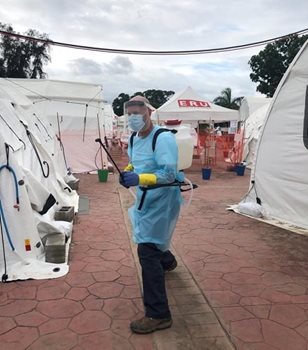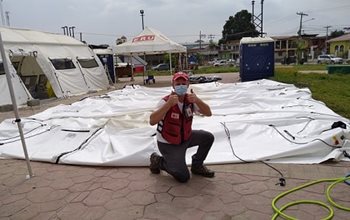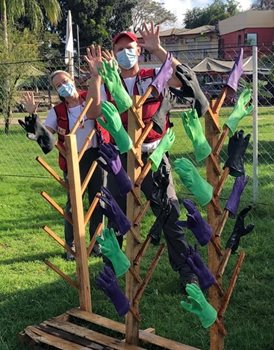By: Michelle Palansky, communications advisor
The Canadian Red Cross maintains an Emergency Response Unit – an emergency field hospital that can be deployed domestically or internationally during emergency response needs. Designed to be self-sufficient in remote or low-resource environments, the unit can be tailored to meet needs on the ground.
Following Hurricanes Eta and Iota, the emergency health clinic was sent to Honduras to provide life-saving aid.

Most Canadian Red Cross international emergency health clinic deployments last four weeks. In fall 2020, however, Garry Enns of Manitoba was the first Canadian Red Cross humanitarian worker to support the clinic from start to finish.
“I started off with a one-month contract and I just kept extending my stay,” explains Enns. “It was valuable to support an entire operation. I was able to observe the transitions between groups of delegates coming and going from Canada and provide unique feedback to the management team in Canada for future deployments.”
Between November 3 and 17, 2020, Hurricanes Eta and Iota impacted people and communities across Central America. The devastation from the hurricanes depleted livestock and destroyed tools, harvests, and farming areas. More than four million people in Honduras, over three million in Nicaragua and over 2.4 million in Guatemala were affected. Thousands of people in Belize, Costa Rica, Panama, Colombia, and Cuba were also impacted.
Garry was sent to La Lima, Honduras, one of the areas most affected by the hurricanes, along with nine other Red Cross delegates tasked with setting up an emergency health clinic to support residents until local medical facilities could reopen.

Deployed as an infrastructure technician for the health clinic, he describes the work he was immediately engaged in.
“My primary responsibility was to assemble the infrastructure for the clinic. This meant leading local Honduran Red Cross volunteers and staff and the CRC humanitarian workers to set up different styles of tents for warehousing, clinic space, administration, pharmacy, and psychosocial support.” Garry continues, “We set up generators and ensured access to sanitation services. Teams from the Spanish and German Red Cross provided the clinic with potable water.”
The time it takes to set up an emergency clinic is dizzying. “From the time the first box arrived, we were up and running and seeing patients within 48 hours. In an emergency like that, it’s critical to get services going as soon as possible,” he explains.
After the initial setup, Garry remained in La Lima to adjust the systems and make improvements to the clinic.
“There are always things that need to be done. In the weeks and months following the clinic opening, improvements and alterations were made as the types of patients and needs of the clinic changed.” Garry adds, “Maintenance was regularly performed on all infrastructure and, keep in mind, things break!”

After three and a half months at the clinic in La Lima, Garry switched to transition mode.
“The goal, if possible, is to leave equipment with the local Red Cross to improve their ability to respond to future needs. Local teams can respond most effectively. They understand the language and culture and context,” he says.
“The Honduran Red Cross has a really strong group of volunteers, and they are well organized and eager to learn. I stayed as the logistical coordinator, helping to develop a program for a one-year transition project that focuses on training and developing teams similar to the team we sent from Canada – people from diverse backgrounds that can assemble quickly and lead a response.”
The Canadian field hospital team brings together professionals with many specialties, including medical professionals, administrators, communications, logisticians and technicians who bring their expertise to the field so that the team can react efficiently and effectively in emergencies.
Each member of the team needs a variety of skill sets and experience to succeed. Garry grew up on a farm in Killarney, MB, where they did a lot of their own construction and mechanics. In Winnipeg, he works as a structural engineer-in-training with a Bachelor of Science in civil engineering and a Master of Science in biosystems engineering.
“You have to be open minded, creative, and patient,” he shares.
Looking back on his deployment, Garry returned again and again to the quality of his team.
“We have such a strong ERU team with the Red Cross. It’s a unique opportunity to work with people from all over Canada, coming together for a common purpose. It’s beautiful to see.”
The Canadian Red Cross is recruiting experienced infrastructure technicians to join our Emergency Response Unit field hospital personnel register. Click here to learn more.
Related stories